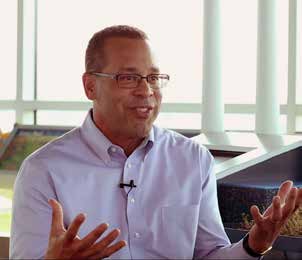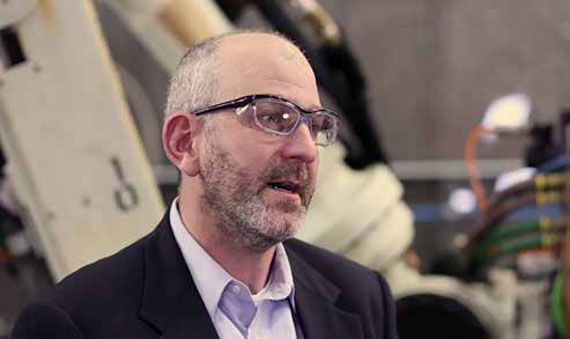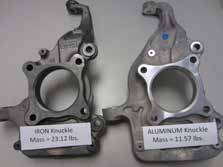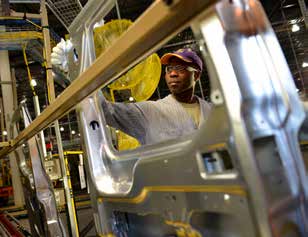Concept To Reality reached out to John Viera, Ford Global Director, Sustainability and Vehicle Environment Matters, and Peter Friedman, Global Manager, Structures and Stamping, Research and Advanced Engineering, to ask them about Ford’s strategy to incorporate lightweighting initiatives into their product design process. Here is what they had to say.

“There is no better way of improving fuel economy than by taking weight out of the vehicle. If you’re driving a vehicle that runs on gas, or electric or hydrogen or natural gas — it doesn’t matter what fuel the vehicle is using — it has less weight, and it takes less energy to move it, and it’s the best way to improve fuel economy.”
— John Viera, Ford Global Director, Sustainability and Vehicle Environment Matters
C2R: Why should automotive companies focus on reducing weight in their vehicles? Viera: When we think about the carbon footprint vehicles actually produce, the largest part of the carbon footprint is the carbon dioxide coming from our tailpipes, so we want to reduce the amount of carbon dioxide. The best way to do that is to improve the fuel economy.
There is no better way of improving fuel economy than by taking weight out of the vehicle. If you’re driving a vehicle that runs on gas, or electric or hydrogen or natural gas — it doesn’t matter what fuel the vehicle is using — it has less weight, and it takes less energy to move it, and it’s the best way to improve fuel economy.
In 2011, when we looked at our product carbon dioxide reduction plan, we stated that we would take out 250-750 lbs in every one of our vehicles. The 250 lbs would be more on our smaller vehicles while the 750 lbs would be on the larger vehicles. We knew that the 750 lbs was going to be very aggressive, but that was the target. Since 2011, I would say that Ford made a big bet on our biggest vehicle, our crown jewel, the F-150; we said that if we’re going to be serious about weight reduction, improving fuel economy and reducing carbon dioxide from our tailpipe, we’re going to do it on our highest volume, best-selling vehicle. We did it on the F-150 and actually saved 700 lbs in the process.
C2R: Could you explain Ford’s strategy for lightweighting?
Friedman: When we started (to redesign) the vehicle, we quickly decided on a lightweighting strategy being the best for the customer, to offer both the attributes and the efficiency. We looked at the most mature technology. What we ended up with was a high-strength steel frame, which takes up to 60 lbs off the vehicle, coupled with a high-strength aluminum panel for the front end cab and box for maximum weight savings.
By making those assumptions early on and getting the platform right, we then could size everything correctly to max the attributes, or, in the case of this truck, beat when I say beat the attributes, it’s in terms of tooling and hauling as well as dent resistance, outer body panels and box floor’s ability to withstand permanent set or denting, which is really important to pickup truck owners.

“As we move to lightweighting, [simulation] has become more important because we have less experience with these materials. And that’s really key. Where we may have 100 years of experience stamping complex steel body panels, we have less in aluminum.”
— Peter Friedman, Global Manager, Structures and Stamping, Research and Advanced Engineering
C2R: Why did you choose aluminum as a key material? Viera: Aluminum is a great lightweighting strategy. In addition to reducing the weight — which improves the fuel economy, which reduces the carbon dioxide footprint that we have — the other element is that aluminum is very recyclable. We have a closed-loop system right out here in the Dearborn Truck Plant. All of the scrap aluminum that comes out of manufacturing the vehicle gets shipped back to our aluminum suppliers and gets reused. So, it’s fantastic from a carbon footprint standpoint because of better fuel economy, and we are reusing all the scrap material from our process, putting it back into our new products as we produce them.
C2R: What challenges did you encounter in the process? Friedman: The use of new materials in body construction, especially the high-volume body vehicle. The first challenge starts with the supply base and getting those materials at the quality you want and the volume you need. Obviously, the F-150 is a very high-selling vehicle, so we need a lot of that high-strength steel and the high-strength aluminum that goes into the body. So, making a decision early to get our supply base prepared to supply to those volumes is the first part.
The second part is our ability to fabricate the parts we need. In the case of aluminum sheet, it’s can we stamp and form with the accuracy we need to get a robust build. Then, obviously, it’s the joining process — what does it do to our bill of process, or the sequence of how we build the vehicle, as well as the joining technology that we need.
C2R: Where do you see lightweighting practices heading? Viera: I think there is a lot of room to grow and to move on lightweighting, so that needs to be a continual focus. Beyond lightweighting, I think there is going to be continual development in the different types of powertrains that our vehicles are actually going to be using — if they’re electric, hydrogen, or much more improved gasoline or diesel engine vehicles. That’s going to happen.
And the other area that is of big interest is what we call sustainable material. Aluminum is a sustainable material because we can recycle it. A lot of our plastic materials are going to come from plant-based sources as opposed to petroleum-based sources, so they will be lightweight and more sustainable because we’re going to grow the material that goes into the parts that go into our vehicles.
C2R: How does simulation play a role in the process? Friedman: Simulation is a key part of body construction and manufacturing the vehicles, in general. As we move to lightweighting, it’s become more important because we have less experience with these materials. And that’s really key. Where we may have 100 years of experience stamping complex steel body panels, we have less in aluminum. And that’s where we rely more on CAE to predict the manufacturability and the accuracy of our processes.
We also use CAE to reduce the amount of prototyping we need to do on the design side by predicting how the vehicle will do in service, durability and safety. We can then go into our prototype build with more confidence and have fewer iterations. It’s about speed to market; it’s about accuracy; and it’s about optimizing the whole system.
I think winning the Enlighten Award is a great honor. Being recognized as an innovator in lightweighting on this vehicle is a great success story. The vehicle is a remarkable statement in the industry, and to do it at such high volume and to be recognized as a game-changer is very important for us.
For more information on how Altair can help you achieve light weight designs, visit http://www.altairpd.com/.
Leveraging a Lightweighting Strategy on the Ford F-150
Owners of Ford trucks expect their vehicles to deliver top performance, safety, efficiency and the ability to handle tough jobs. That’s why Ford engineers took great pains when it came to redesigning the F-150 trucks.
In fact, the Ford team established a new standard for full-size pickups by bringing together improved capability and efficiency, along with cutting-edge smart vehicle technology. The team employed lightweighting strategies in their design initiatives and new manufacturing processes. The combination resulted in Ford F-150 models that were 700 lbs (318 kg) lighter than previous models.
A Material Advantage:

High-strength, military-grade aluminum alloys were used throughout the F-150 body for the first time. The overall weight savings enable the 2015 Ford F-150 to tow more, haul more, accelerate quicker and stop shorter — all contributing to efficiency.
In addition, Ford increased the amount of high-strength steel from 23 percent to 78 percent. By doing so, it improved the stiffness of the frame while reducing weight by as much as 60 pounds.
The high-strength, military-grade aluminum alloy body is approximately 400 lbs of weight savings over the outgoing steel body. Although it is more expensive than steel on a pound-for-pound basis, it allows Ford to maintain its truck leadership with more capability and durability improvements across the entire lineup.
Innovative Design:
The Ford team took a holistic approach to weight reduction. It incorporated advanced materials not only in the frame and body but also in the powertrain, battery and interior features, such as seats.

Ford added thickness to the high-strength aluminum alloy used in the 2015 F-150 and added structural reinforcements to achieve strength comparable or superior to the previous-generation F-150. As a result, the new truck’s doors and cargo box are more resistant to dents and dings. What’s more, the alloy in the new F-150 does not produce red rust, like steel. Ford notes that it has gone to great lengths to develop coatings that will inhibit corrosion.
In the design phase of the project, Ford used a novel process. Its research team, which had the most experience working with advanced materials, remained engaged with the vehicle engineering team from the beginning of the project through the final delivery of the vehicle.
Manufacturing Updates:

In order to move forward with manufacturing the newly redesigned trucks, Ford had to upgrade its Dearborn Truck Plant and Kansas City Assembly Plant. The company did so in 13 weeks, a record for Ford and the industry. During that time, Ford overcame the challenge of shifting from traditional steel body production to advanced aluminum alloy production, including new ways to receive and handle aluminum alloys and reduce aluminum manufacturing waste.
For example, at the Dearborn Truck Plant, new press lines were added to help stamp four different types of high-strength aluminum alloys. New hydroforming lines that used pressurized oil enabled manufacturers to form metal tubes into strong support rails for structural soundness.
According to Ford, a new chemical coating system that prepares the aluminum for high-strength adhesives and a new heat treat bake area that hardens the alloys were also added. Most welding equipment was replaced with advanced riveting and bonding hardware.
In the Kansas City Assembly Plant, Ford rolled out an all-new body shop with more than 500 new robots leveraged for state-of-the-art joining technology, installing roof and door panels, and transferring the light-weighted trucks to final assembly. Camera-equipped robots also were used to scan truck bodies to ensure the highest quality standards were met.
The paint shop was also updated with dirt detection technology, and the use of robotic paint automation was increased for a durable, best-in-class exterior appearance. Innovative production processes were added to support the installation of new truck features, including a 360-degree camera with split-view display. To replicate extreme, real-life road conditions, a rough-road test course was installed to ensure delivery of a quiet, more durable truck.
Beverly A. Beckert is Editorial Director of Concept To Reality.